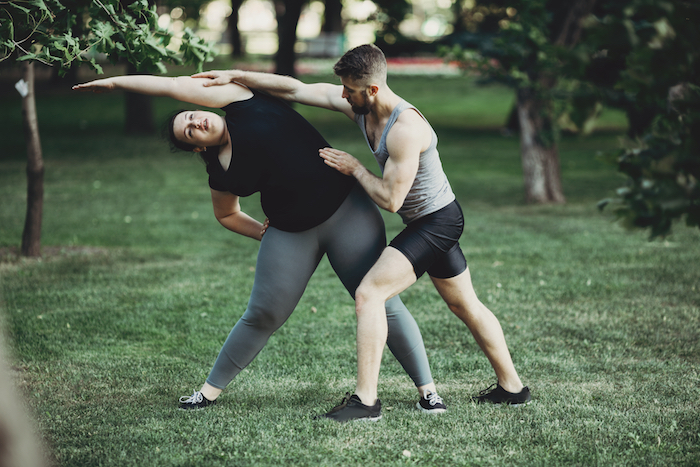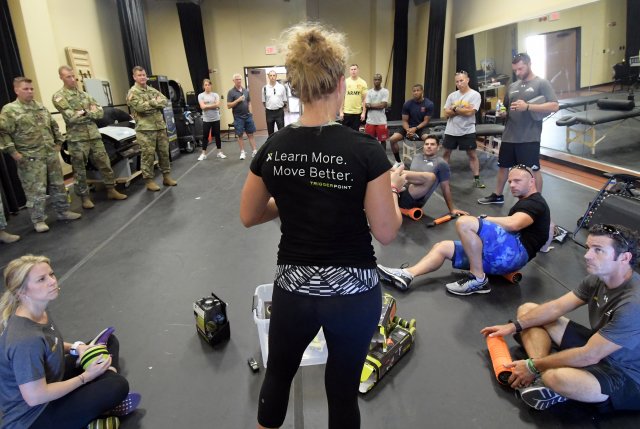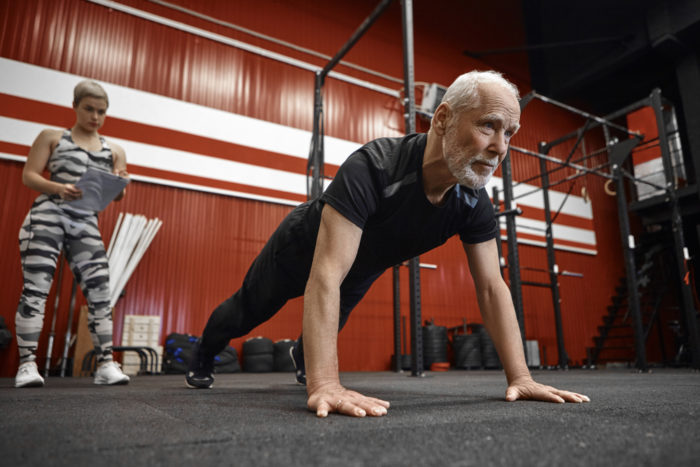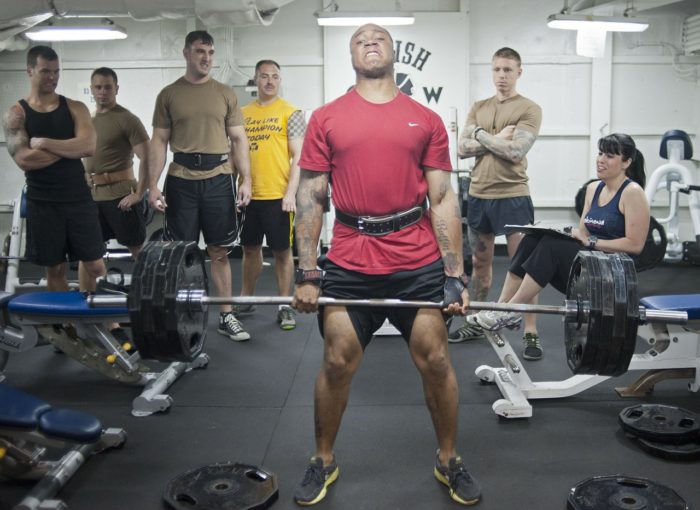When you step into a gym, what are your goals? Where did you get those goals? Did someone tell you you’d look better in that shirt, that dress, if you just would do x or y? Did someone — more frequently, this is the case — praise you for looking one way, and remain silent when you didn’t look that way? Because that, too, is a form of telling you how to look; and how not to look.
Many of us have aesthetic body goals when we step into the gym or the kitchen. These goals are all shaped by an intricate interaction between us and the people in our lives, and the supposedly objective health information floating out there in fitness magazines and casual conversation. We internalize many standards, sometimes even when we realize that these standards of whose body is healthy and whose is not change over time and place and culture.
As a personal trainer, I know I’ve been taught to prioritize certain aesthetics over others; usually, those aesthetics that come along with my training to be a fitness coach value a 2019 white American, able-bodied, bigger-is-better-unless-you’re-a-woman aesthetic. Trainers who don’t match this ideal ourselves often suffer in the industry until we’re able to find people (and there are always people) who want to be trained by someone whose body strays from the aspirational norm.
Because the aspirational norm hurts, and the aspirational norm causes damage. How do I, as a personal trainer, work toward body affirmation, body positivity, with my clients (and myself) when intense scrutiny of bodies is literally my job?

1. The Right Way to Assess Your Client’s Needs
Personal trainers are often taught the power of the motivational interview, the digging deeply into someone’s stated, vague desire to get underneath it all. Exposing the raw core of our wants, the logic goes, will serve as stronger motivation than surface-level statements.
Yet we are most often taught to go into motivational interviewing —in complimentary assessments, during our sessions, etc. — with a certain goal already assumed. We are taught to assume that of course a client wants to lose body fat; that a woman doesn’t want to “bulk up”, but a slimmer man does. These things are often true! As a transmasculine person, I do want to bulk up, and more muscular definition does involve losing body fat!
But we often assume these goals right out of the gate. It’s in our language while we’re talking to clients, always. It’s in the forms we will out that say “male” or “female”, and it’s in the standards for body fat percentages and heart rate that assume so much about a person based on their assigned gender at birth. I always apologize for the binary choice required forms give my clients for gender, and I let them choose what to pick instead of checking a box for them. I offer to make any clarifying notes they want me to.
When an assessment room at a box gym is full of clinical, doctor’s office-looking charts meant to shame certain bodies while praising the slim few, I apologize for the setup because I know it’s intimidating. This simple statement opens up my clients in so many ways; for the most part, they immediately feel more comfortable telling me about their exercise histories and goals, because they immediately feel less judged. The platform is theirs to make choices, rather than me putting them on a platform to be prodded and assessed.

I never bring up body fat unless my clients do first. And when they do, I repeat the words they use, that they seem comfortable with. I don’t inject my own interpretation and value judgement into the conversation. Because personal trainers are professionals! We are the ones with the power in these conversations, and clients will often defer to us and what we think is good for them. Injecting my own words into the conversation takes away their agency over what they want with their bodies. And agency is what we’re supposed to be promoting, isn’t it?
I explain that the standards of body fat percentages and such have been created in a white, cis-male, able-bodied vacuum of research that mostly focuses on young, athletic men. My clients generally laugh in relief, like they’d always suspected as much but have nonetheless blamed themselves for not fitting those standards all along.
And that self-blame makes sense when we think about how we’re taught to talk about fitness. “Shredding” fat, “torching” calories. We speak so violently of our own bodies, and of our clients’. We make our bodies the enemy that must be raized, and we create demons out of our own skin.
Our bodies, instead, can be respected and cherished, perhaps in a new way, through fitness programming that affirms, rather than shames, our diverse bodily realities.
[Read more: How Body Standards Impact Female Strength Athletes.]
2. Empathetic Coaching: In-Session Interactions
We all know the drill sergeant stereotype of a personal trainer. That is, in fact, what most people still think of when they think of our profession. That methodology works for many, I’m sure. But in my experience, it more often works for those who are already close to the desired cultural body norms, and it shames those who are farther from it.
During sessions, I don’t criticize a client for being winded or needing a break. I empathize with their need and I pass them their water bottle and towel. Instead of criticizing a client for tapping out during a set, I wait. I later — when, inevitably, their work capacity increases — remind them that last time we did this, they had a more difficult time with it. I praise how far they’ve come, rather than criticizing where they are.
I have clients who want a drill sergeant, so I work them as hard as they want to be worked; but I do it with “see if you’ve got two more” and “take as good a rest as you need right now, because you’re going to need it” rather than commands that belittle and shame.
There is enough shame in the world. We don’t need it in our sessions.

3. Let Your Client Lead: Shaping Your Programming
There are areas of expertise that I have as a personal trainer that my clients lack. That is literally why I have a job. Yet, I am not an expert in living in my client’s body: my client is. My client is, always, the foremost expert at living in their body and knowing what they want.
So if I have a client that hates working out in the stereotypical ways, I’ll find out how they like to move. Do they like to play rather than do strict reps and sets? I’ll design the most play-friendly workout program they can imagine. Do they hate cardio, as so many say off hand? I’ll work with them to find out what exactly they hate and talk through how to get where we need to go without making them miserable about the journey.
I review each component of my programming with clients (more or less depending on how much they actually want to be involved in this aspect). I explain why I’ve done things the way I have, but I also ask them for a wishlist: what they want to be able to do, what they might have seen people doing that they wish they could, what they love and want to do more of. I build programs around a client’s desires, because it’s their bodies that are being affirmed in this process, not my assumptions about how they need to get to the next level.
[Want to design a program? Here’s our 3-step guide to building your first workout program.]

Moving Forward: Body Positive Personal Training
Whether in my classrooms or on the gym floor, I always ask myself these questions:
- Who am I welcoming with my language?
- Who am I casting aside?
- Who am I prioritizing, and who am I shaming by default?
- Am I an impassive, emotionless tower of masculinity in the face of my clients’ obvious pain?
- Or am I an empathetic coach who’s on this journey with my client, letting my client define where we should go instead of deciding for them?
- Who am I helping by upholding only one standard of what bodies should be? Who am I hurting?
Surely, this is not a profession that markets itself as one that hurts; it markets itself as one that helps. Let’s continue to ask ourselves who we hurt under the mask of help, and remove that mask from our coaching practice. Body positive coaching enhances both the client and trainer experience; we just have to do the heavy lifting of unlearning our most celebrated fitness assumptions to do it.
Featured image via Flotsam/Shutterstock
